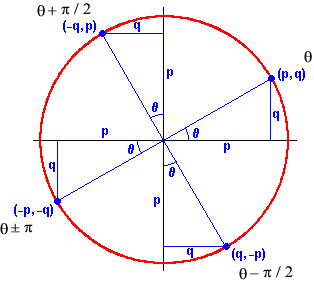Trigonometric Functions
Algebraic Representation![]()
|
f(x) = a sin [b (x + c)] + d |
Members of this family have four parameters to change when shaping themselves to model periodic phenomena:
The dilations also have informal names. When
The meaning of these suggestive terms is most apparent when looking at the graphs of the trigonometric functions. With so many parameters to "tune," however, it is clear that this family has great algebraic flexibility.
![]() The key algebraic property of the sine and the cosine functions is their periodicity:
The key algebraic property of the sine and the cosine functions is their periodicity:
sin (q ± 2kp) = sin (q)
cos (q ± 2kp) = cos (q)
That is, adding or subtracting any angle of 2kp radians (k times around the circle) to or from any angle q takes us back to the same point on the circle, the same y and x coordinates, and the same sine and cosine. Said another way, if we know the values of these functions for q between 0 and 2p, then we know the values for any q .
The length of the shortest input interval containing all of the information about a periodic function is called the period. Both the sine and the cosine have periods of 2p .
Another important algebraic property of trigonometric functions is the relationship between the sine and the cosine. Their behavior is very similar. In fact, each time we change our position on the unit circle by p/2 radians (90º), the x and y coordinates simply reverse themselves, while one of them changes sign:

We see that:
and that:
These relationships are examples of trigonometric identities. Identities give us equivalent ways of saying identical things. In particular, the identity
There are many other useful identities related to the sine and cosine functions. Like the identities above, they come from observing the many pleasing symmetries of the circle.
There are other trigonometric functions that are sometimes used in applications. All of them, however, are simple ratios of the sine and cosine. Just as we understand rational functions by observing the behavior of the polynomials in their numerators and denominators, so the remaining trigonometric functions can be understood in terms of the basic behaviors of the sine and cosine.
The trigonometric functions have been around for a long time. Their origins, however, were not in the study of periodic phenomena. Rather, early trigonometry concerned itself with the ratios found in right triangles. (Greek roots: tri, three + gonia, angle + metria, measure.) Even if it has little to do with modeling, the subject is still eminently practical.
Introduction to triangle trigonometry ![]()
If you'd like to learn more about the long history of the trigonometric functions, go here.
|
|
|
| Back to Contents | |